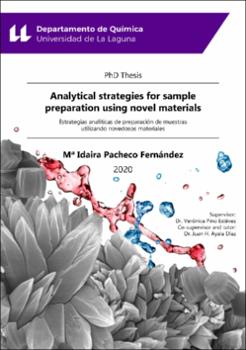Analytical strategies for sample preparation using novel materials
Fecha
2020Resumen
Sample preparation is the stage of the analytical procedure that deals with the extraction
of the target compounds from a sample and includes the elimination of the interferences coming
from the sample matrix, thus ensuring the compatibility with the analytical instrument while
improving the selectivity and sensitivity of the entire method. Given the complexity of the samples,
the trace concentrations at which analytes are present in the samples, and the importance of
incorporating the Green Chemistry principles in the analytical process, the development of
microextraction techniques and the incorporation of new materials have been demanding research
lines within analytical sample preparation to address these challenges.
Among the outstanding materials described that can meet green requirements and exhibit
successful analytical performance in sample preparation, ionic liquids (ILs) and metal-organic
frameworks (MOFs) must be highlighted.
ILs are molten salts formed by the combination of bulky organic cations and organic or
inorganic anions. They present melting points lower than 100 °C and, depending on the moieties
selected and the incorporation of specific functional groups in their structure, they can exhibit
specific characteristics. Therefore, it is possible to prepare several interesting derivatives, such as
polymeric ionic liquids (PILs) and IL-based surfactants.
MOFs are crystalline materials composed of metallic clusters and organic linkers connected
by coordination bonds. They are mainly characterized by their high surface area and tunability,
which allows designing MOFs with specific topologies by selecting the adequate components and
synthetic conditions. These characteristics make MOFs potential materials to host target
compounds.
In this Doctoral Thesis, ILs and MOFs were designed, synthesized and incorporated in a
wide variety of challenging analytical applications using microextraction techniques. Among the
existing techniques, dispersive liquid-liquid microextraction (DLLME) and solid-phase
microextraction (SPME) were selected due to their simplicity, fastness, and high preconcentration
ability.





